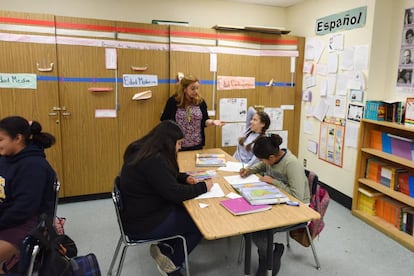Number of Spanish speakers worldwide soars to 572 million
Around 754 million people expected to speak language globally by 2060, new report shows

Over 572 million people speak Spanish worldwide, of which 477 million people are native speakers, according to a new report from the Spanish government’s Cervantes Institute.
In its annual report, Spanish in the World of 2017, the language and culture institute found that the number of Spanish native speakers jumped by 5 million between 2016 and 2017.
The United States will have the biggest population of Spanish speakers in the world after Mexico by 2060
Juan Manuel Bonet, director of the Cervantes Institute, said the findings show that the Spanish language is in “good health.”
“People are not leaving the Americas like before. Now people want to work there and it draws people in. Spanish is very useful. It opens markets,” said Bonet.
According to the report, Spanish continues to be the second-most spoken mother language – topped only by Mandarin which is spoken by 950 million people. Today, Spanish is spoken in 7.8% of the world, a percentage that is predicted to remain the same until at least 2050 – unlike those for Mandarin and English which are expected to drop.
The study carried out by David Fernandez Vitores, a philology professor at the University of Alcalá, found that in addition to the 477.6 million native speakers, a further 73.7 million people have some knowledge of Spanish and another 21.2 million study Spanish as a foreign language – a total of 572.6 million people.
This number is expected to rise to 754 million people by 2050, pushed by population growth in Spanish-speaking countries as well as the growing number of Spanish speakers in the United States.
By the middle of this century, Spanish will break apart the English-only model in the US Juan Manuel Bonet
Indeed, according to the official US census, the United States will have the biggest population of Spanish speakers in the world after Mexico by 2060, and around 28.6% of the population will be Hispanic.
Today in the United States, there are 43 million native Spanish speakers and another 15 million people with some knowledge of Spanish.
“Spanish has a lot of weight in Latin America, but the most interesting news is how Spanish has grown in the United States. By the middle of this century, Spanish will break apart the English-only model,” said Bonet.
In the United States, Spanish is the most studied language at all school and university levels. The number of students enrolled in Spanish courses is higher than the total number of students enrolled in all other languages.
The director of the Cervantes Institute also highlighted the popularity of learning Spanish in China: “There is great interest in China. There is a big growth in demand. China has economic interests in Latin America.”
More than 21 million people study Spanish as a foreign language worldwide – it competes with Mandarin and French as the second-most studied language in the world.
The number of students enrolled in Spanish courses is higher than the total number of students enrolled in all other languages
Over its 26-year history, the Cervantes Institute has seen Spanish enrollments rise eight times from 17,000 to 142,000.
“As an institute we are dedicated to teaching the Spanish language. Our centers are defenders and bastions of the Spanish language,” said Bonet.
The number of students studying for a Diploma of Spanish as a Foreign Language (DELE), which is issued by the Ministry of Education and Culture, has likewise jumped from 7,800 to almost 90,000 in the last quarter of a century.
“The economic value of Spanish is very important in the publishing, audiovisual and economic industries. But we have to work to strengthen its presence within scientific publications," said Bonet.
English version by Melissa Kitson.
Tu suscripción se está usando en otro dispositivo
¿Quieres añadir otro usuario a tu suscripción?
Si continúas leyendo en este dispositivo, no se podrá leer en el otro.
FlechaTu suscripción se está usando en otro dispositivo y solo puedes acceder a EL PAÍS desde un dispositivo a la vez.
Si quieres compartir tu cuenta, cambia tu suscripción a la modalidad Premium, así podrás añadir otro usuario. Cada uno accederá con su propia cuenta de email, lo que os permitirá personalizar vuestra experiencia en EL PAÍS.
¿Tienes una suscripción de empresa? Accede aquí para contratar más cuentas.
En el caso de no saber quién está usando tu cuenta, te recomendamos cambiar tu contraseña aquí.
Si decides continuar compartiendo tu cuenta, este mensaje se mostrará en tu dispositivo y en el de la otra persona que está usando tu cuenta de forma indefinida, afectando a tu experiencia de lectura. Puedes consultar aquí los términos y condiciones de la suscripción digital.
More information
Últimas noticias
Aquilino Gonell, former Capitol sergeant: ‘If it hadn’t been for the police, the US would be a dictatorship’
A hybrid building: Soccer pitch, housing, and a shopping mall
Europe urges Trump to respect Greenland following annexation threats
Science seeks keys to human longevity in the genetic mixing of Brazilian supercentenarians
Most viewed
- Alain Aspect, Nobel laureate in physics: ‘Einstein was so smart that he would have had to recognize quantum entanglement’
- Mexico’s missing people crisis casts a shadow over World Cup venue
- Why oil has been at the center of Venezuela-US conflicts for decades
- Alvin Hellerstein, a 92-year-old judge appointed by Bill Clinton, to preside over Maduro’s trial in New York
- Cuba confirms death of 32 of its citizens in the US attack against Venezuela










































